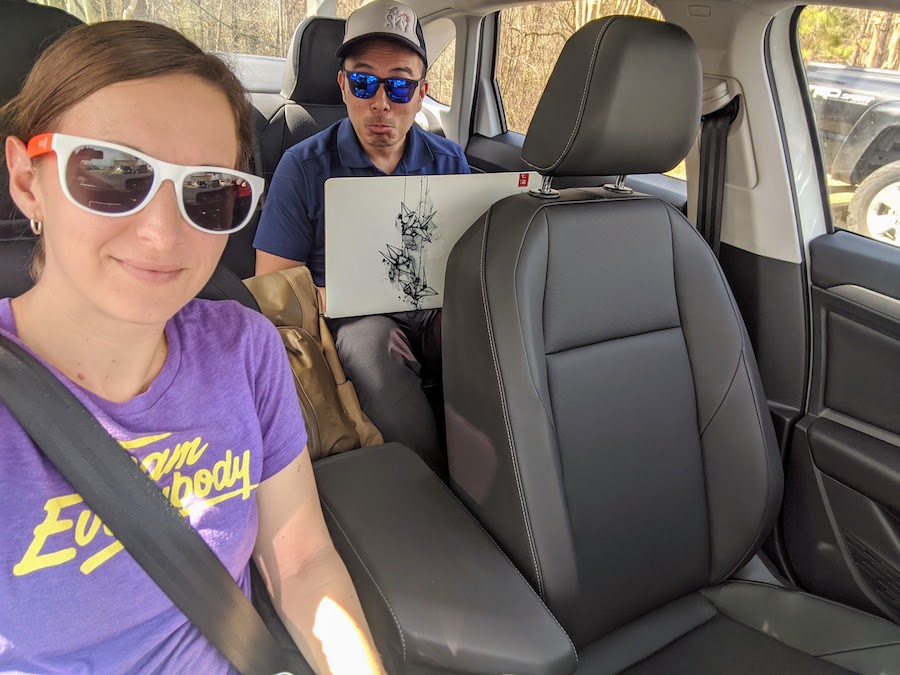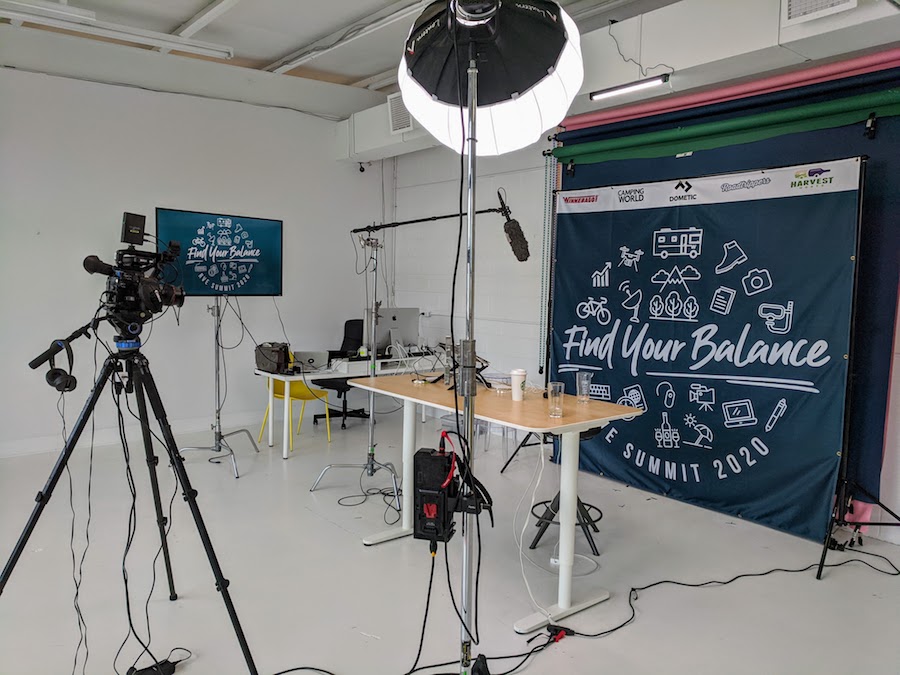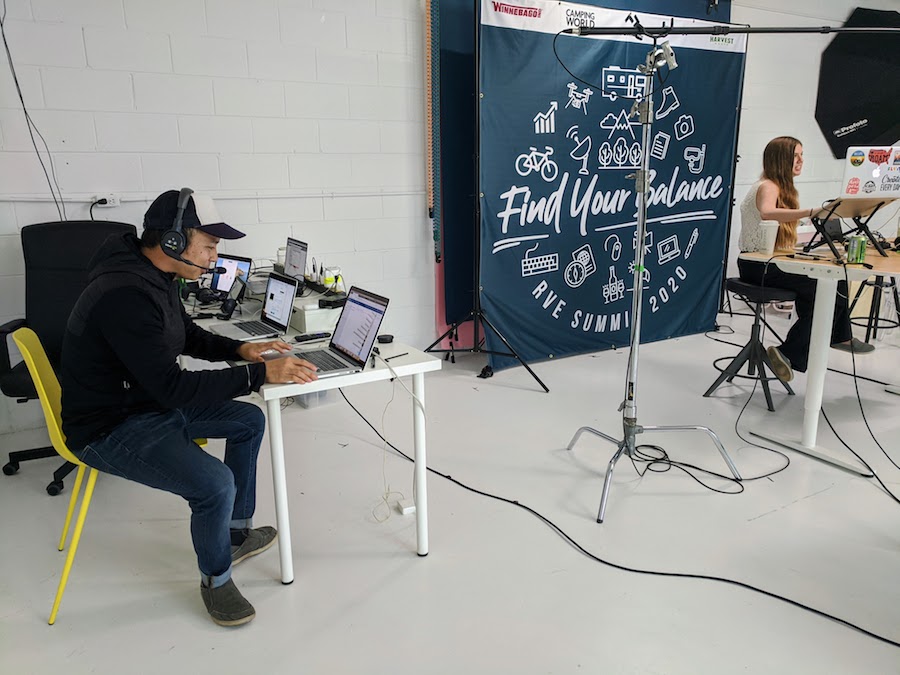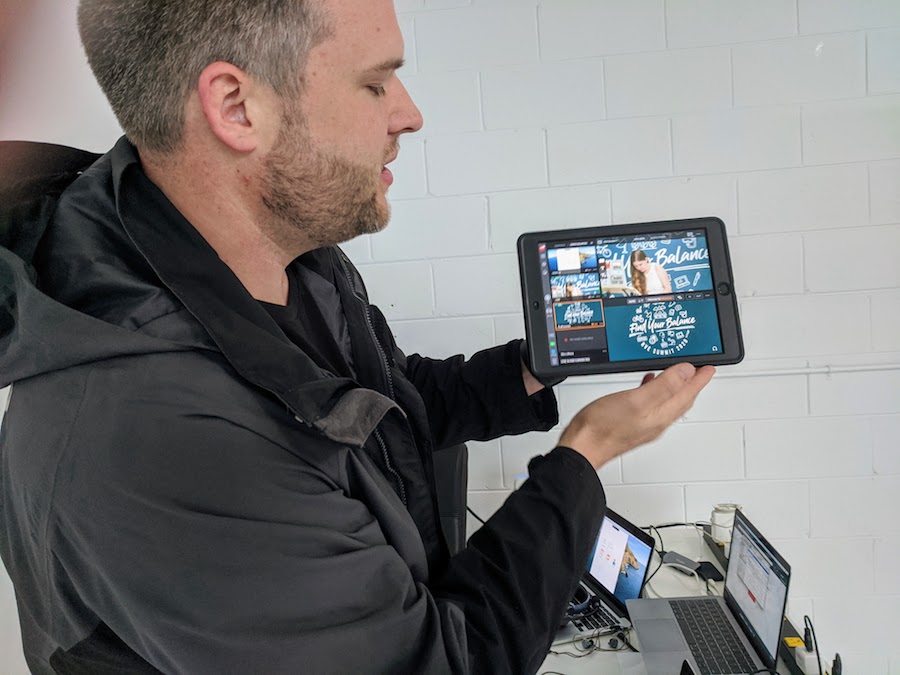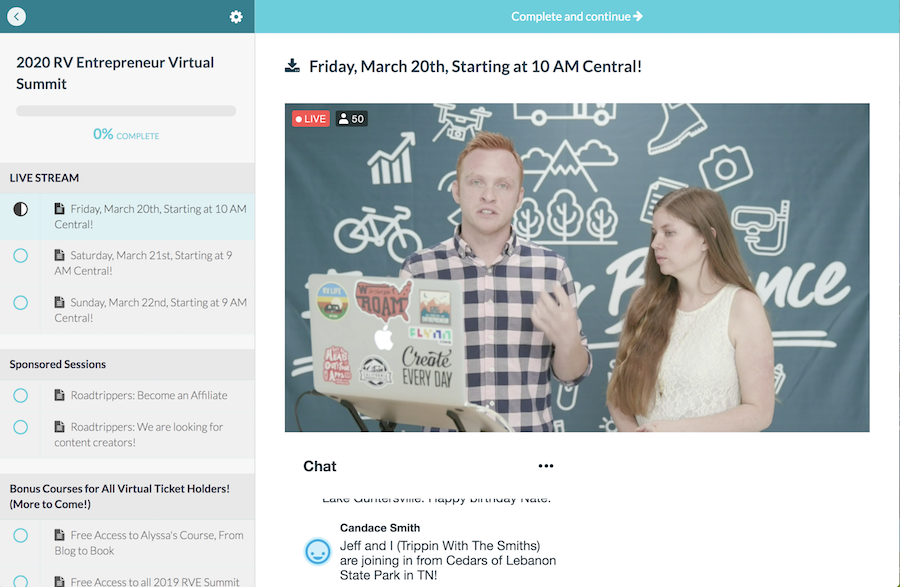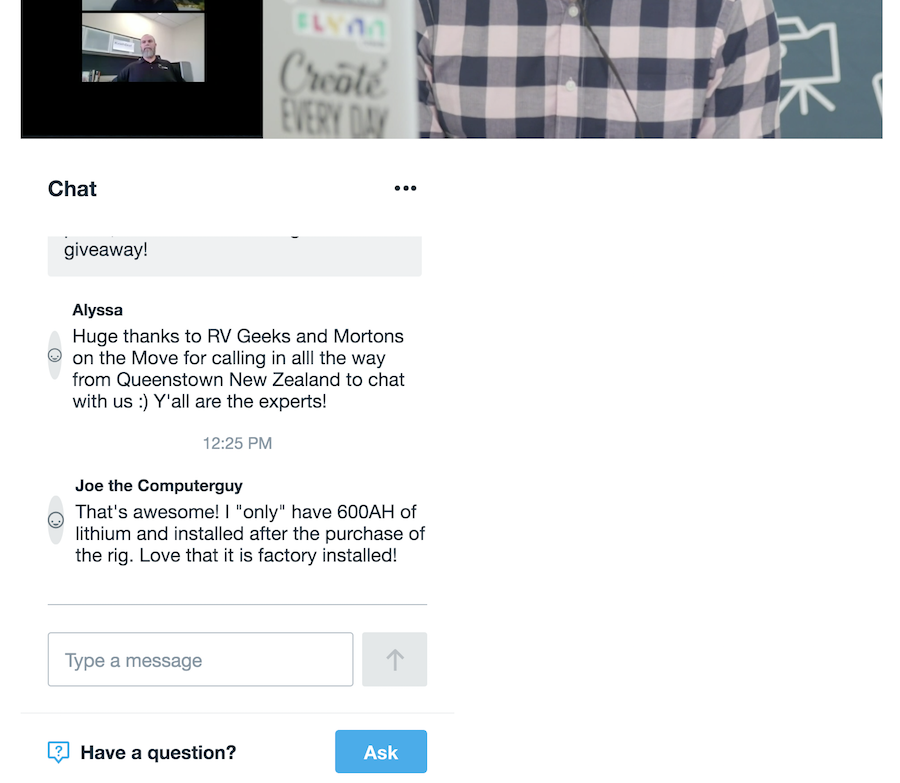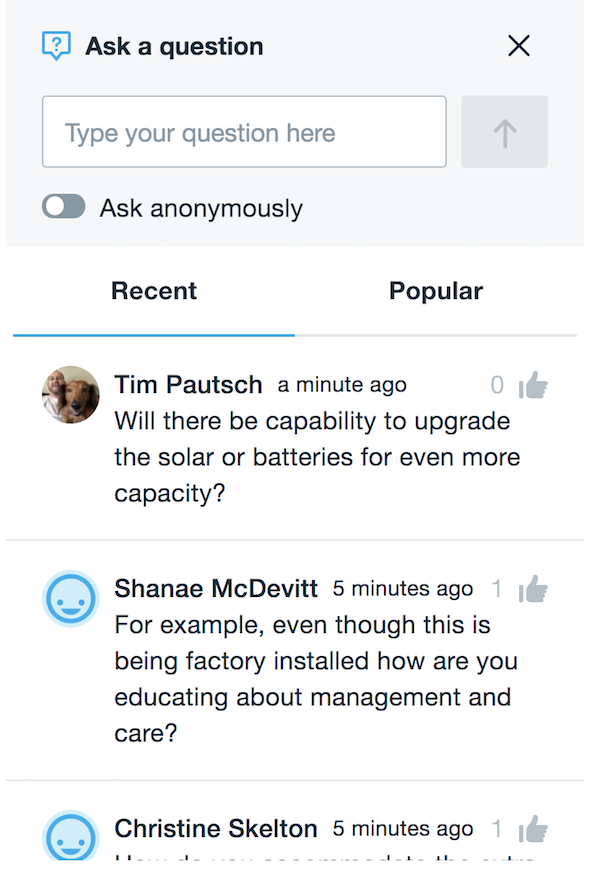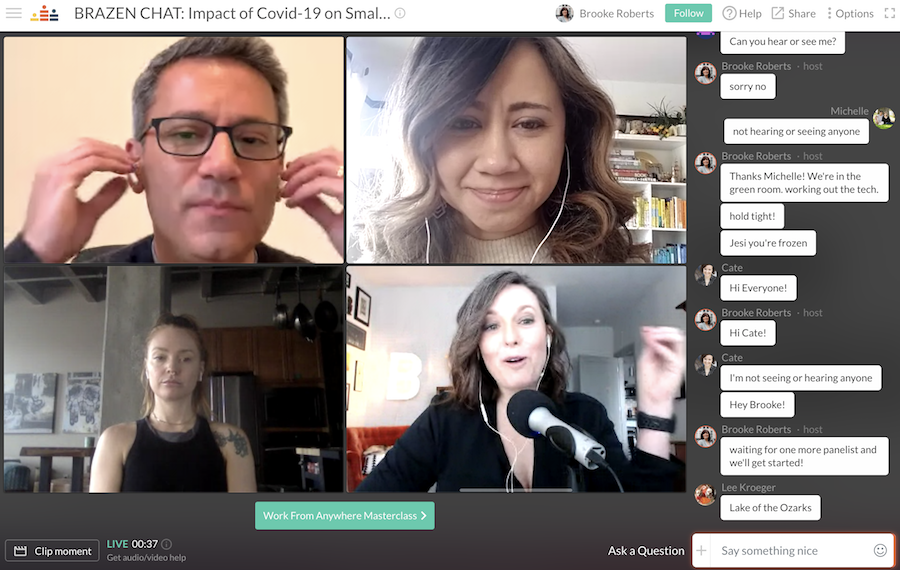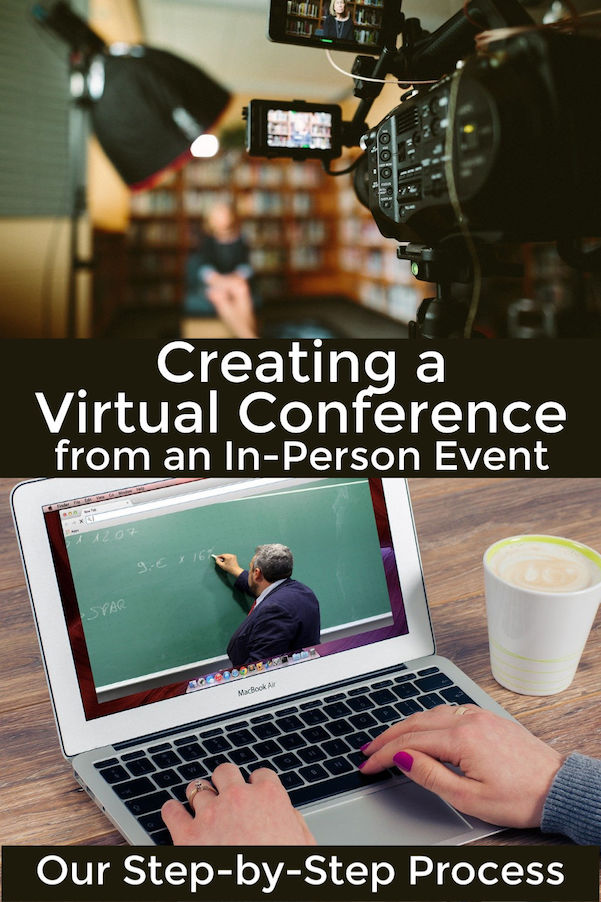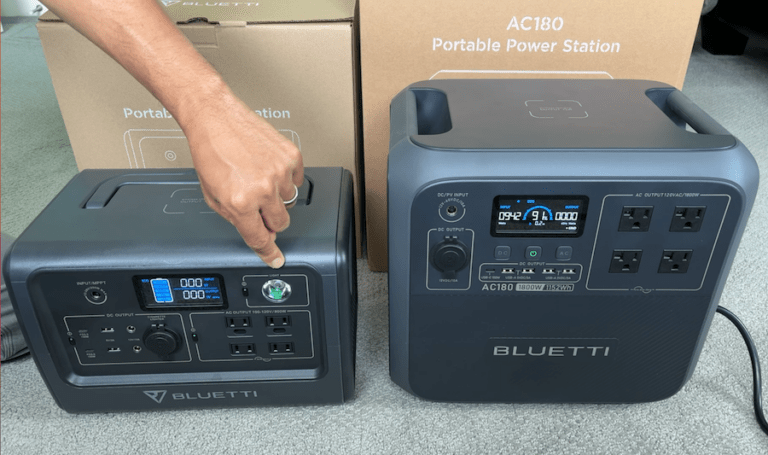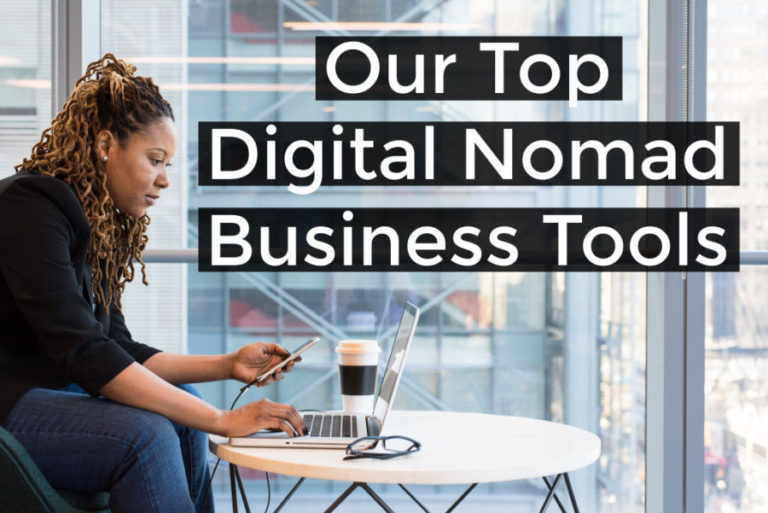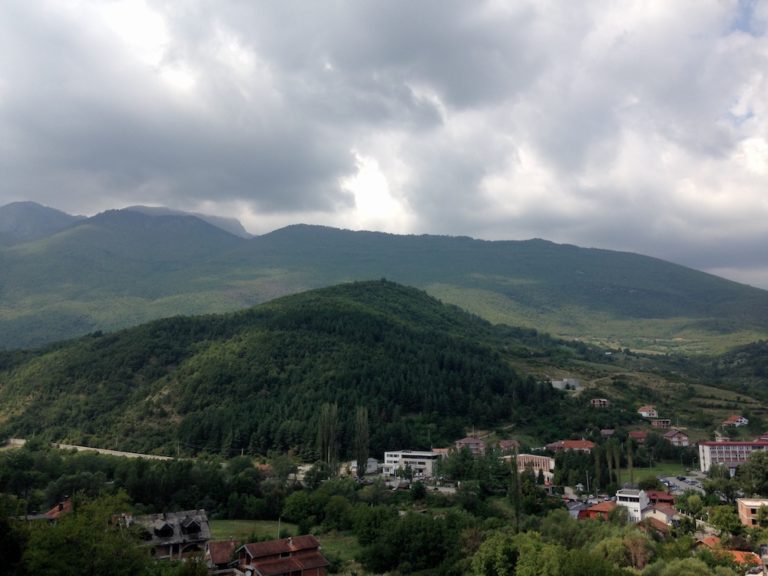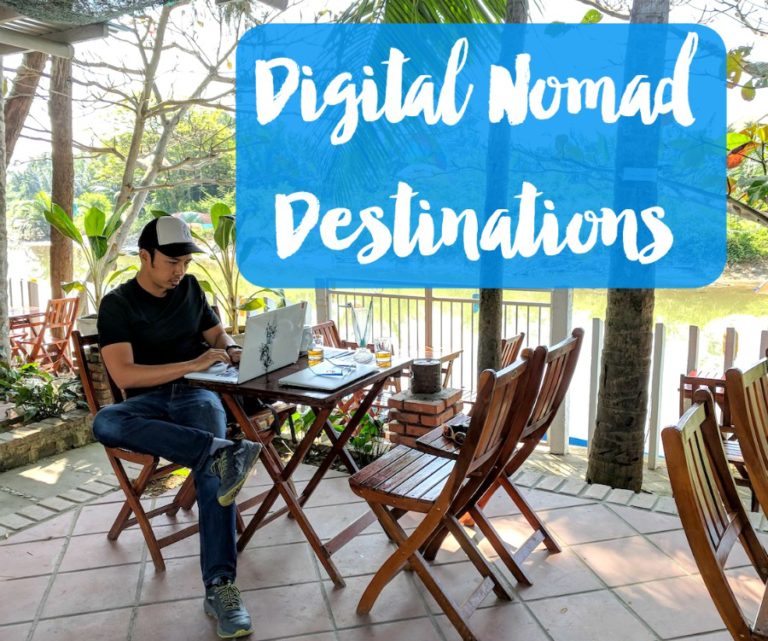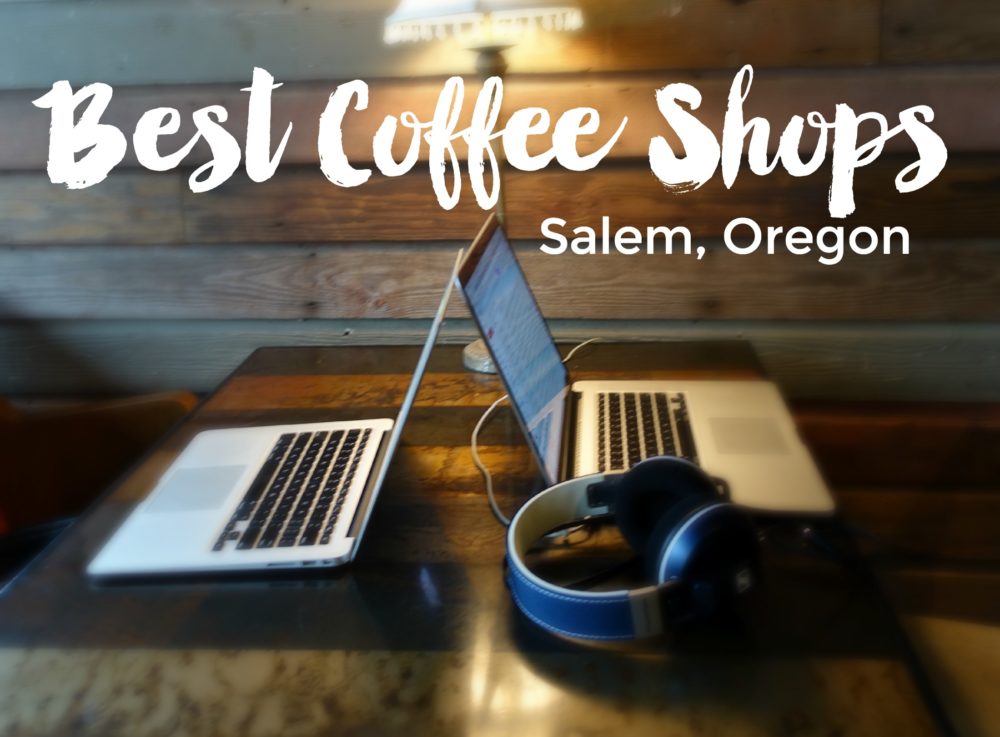How to Create a Virtual Conference From An In-Person Event Post-Pandemic
COVID-19, a.k.a. the Coronavirus, is significantly impacting events and conferences. Recently, one of the in-person conferences that we both work on suddenly needed to become a virtual event at the last minute.
Knowing that other event planners, meeting coordinators, and conference organizers will likely be in similar situations during Coronavirus lock down, I thought it might be helpful to share what our event planning team has done step by step and what we’ve learned through this process.
In this post, we’ll cover:
– Choosing between canceling an event vs. postponing vs. creating a virtual event
– How to change your event quickly
– What is a virtual conference or a virtual summit?
– How does a virtual conference work?
– Best virtual conference platforms
– How to organize an online conference
– Lessons learned from transitioning an in-person conference to an online event, using the RV Entrepreneur Summit as a case study
What changing from in-person to online looked like for the RV Entrepreneur Summit
Background about our event case study
Our friends, Heath and Alyssa, have created a thriving community of entrepreneurs and remote workers who live full-time in RVs, motorhomes, and campervans. For the past four years, they’ve hosted an annual RV Entrepreneur Summit with keynote talks, workshops, and meetups about the nomadic lifestyle and online work.
For full-time RVers who are constantly on the move, it’s a rare opportunity to come together and build community, so most bring their homes-on-wheels and stay on site for weeks or even months. The official Summit sessions go for three days, but pre-conference meet ups and an attendee coworking space go on for about a week.
Last year, we were brought on to help produce the 3rd RV Entrepreneur Summit. It took place at a State Park in Alabama with a large, lake-side campground and conference venue spaces nearby in their Lodge. This year’s Summit was slated to be at the same location. There were over 250 attendees registered for the conference, plus over 60 signed up for the kids program.
Many attendees, as well as our friends who host the Summit, had already started trickling in to the campground in the weeks before everything changed.
Jedd and I had been working with Heath and Alyssa to support their event planning and communications remotely since the previous Fall. We had flown across the country more than a week prior to the Summit in March, when concerns about the virus outbreak were uncertain. No cases had been reported in Alabama, where our gathering would be held, and we knew the attendees–RVers–had a relatively low risk of exposure to large crowds. Still, our concerns about hosting the event increased as the week went on.
When everything changed
On Wednesday night, March 11, WHO declared the Coronavirus a pandemic, and Trump addressed the nation. Early Thursday morning, Jedd and I started a 9+ hour drive from Florida to Alabama. During the drive, we took a call with Heath and Alyssa to discuss the growing concerns about hosting an in-person event less than a week away.
Registration for the RVE Summit was supposed to start Thursday, March 19, just one week later; but really, pre-conference activities were slated to begin as early as Monday, just 4 days away. The pressure was on to make a decision quickly.
For many reasons, which I probably don’t need to explain, it became apparent that we should cancel the in-person gatherings for the coming week. We then had three options to weigh: cancel the Summit entirely, postpone the Summit to a later date, or modify the Summit into a virtual conference.
Our deliberation was actually pretty short. Due to our own personal commitments for the year and the uncertain future surrounding the virus outbreak, postponing the event was dismissed. With so many attendees already on their way, venue and vendor deposits made, and a sense of commitment, we opted to create an alternative that would best serve all involved: a virtual conference.
This is us pulling over in a parking lot during our road trip as we suddenly needed to recreate the RV Entrepreneur Summit into a virtual event within a week
How to choose between canceling an event vs. postponing vs. creating a virtual event
Here are some of the questions we asked ourselves before making the choice about what to do with our event in light of the Coronavirus situation:
Financial Considerations
– What payments and resources can be recouped? (Can venue deposits be used for other purposes? Can items purchased still be used in another way?)
– What have other stakeholders paid that might need to be refunded? (Have attendees paid for tickets? Have sponsors contributed money or resources?)
There is usually a financial cost to changing or canceling an event. A rough calculation can be made for each potential scenario to find out which option is favorable financially.
In our case, deposits to the venue for meeting rooms were non-refundable but unused campsites, Lodge stays, and meals could be recouped. 2020 Summit T-shirts and other vendors had already been paid out. So some significant, hard costs were already sunk, which amounted to roughly 25% of the ticket price for attendees.
Attendee tickets had technically become non-refundable in January. Though it was no one’s fault that COVID-19 caused the event cancelation, we knew we could just keep everyone’s money.
Ethical Considerations
– How can you best honor your commitments? (How do you want to treat your attendees, vendors, sponsors, and other stakeholders? Can they afford to share some of the cost or is it fully your responsibility as event host?)
With the RV Entrepreneur Summit, the attendees and sponsors were part of a loyal community Heath and Alyssa have fostered for years. Fulfilling commitments to them was just as important in the decision as making sure no one was left high and dry financially.
Logistical Considerations
– Can the venue and vendors accommodate the event at another time? (Is a later date available? Can prepaid deposits be transferred if the event is postponed?)
– Will attendees come if it’s rescheduled? (Is the event still relevant at a different time? Will attendees’ tickets automatically apply to the new date, or will everyone be refunded and need to purchase tickets again?)
– Do you have the resources and bandwidth to coordinate a virtual event? (Do you have someone with the expertise to set up online sessions? Are speakers willing and able to contribute virtually? Can vendors and sponsors still participate somehow?)
In our case, we were lucky that the Summit was going to be video recorded already. Further, the video team were good friends and lived nearby. We were able to quickly confirm that our video team could accommodate the switch to recording and broadcasting a live virtual event. Because we kept the same event dates, we knew everyone–crew, attendees, and speakers–would still be available.
To summarize, these were the pros and cons for each option:
Canceling the Summit
Pros: Quickest and least amount of work
Cons: Disappoint attendees, lose out on money paid to venue and vendors, forfeit any profits from tickets (or keep profits and burn your bridges)
Postponing the Summit
Pros: See your plans come to fruition, potentially maintain revenues, may not lose deposits paid, have time to adapt
Cons: May duplicate some expenses, requires additional work, no certainty when Coronavirus issues will resolve
Adapting to a virtual event
Pros: Still delivers value to attendees and sponsors, potentially maintain a portion of revenues, leverages content already planned, keeps original timeline
Cons: May lose out on a portion of money paid to venue and vendors, requires additional expertise and work
How to change your event quickly to Virtual
Within 15 minutes, our team knew that attempting a virtual conference was the best solution for the RVE Summit. Here’s what we did next:
- Started listing questions we needed to answer and immediate tasks we needed to complete before we could officially inform attendees
- Informed speakers, sponsors, and attendees that the in-person gatherings would be canceled and shifted to an online format
Here are the list of tasks we completed in the first few hours:
– Confirmed that the video team could do a livestream event
– Notified the original venue of our desire to cancel and inquired about refunds
– Confirmed whether sponsors would still be in if we went virtual
– Confirmed whether most speakers and workshop leaders would still be available to present virtually
Once we had most of the above things vaguely in place, we drafted an e-mail and Facebook post to inform attendees of the change. The announcement with subject line: “COVID-19 Update: RVE Summit is going 100% virtual” went out Thursday afternoon, maybe 6 hours after we made the call to revamp.
The Summit attendees started responding in the private Facebook group immediately with support and empathy. We did receive a few requests for full refunds but waited to respond to those until we had further discussions.
Over the next day, we then worked on these tasks as we prepared for our next announcement:
– Calculated total costs (old and new) to estimate a partial refund amount we could provide for current attendees and a new virtual ticket price for new virtual conference sales
– Estimated amount of expenses paid out per person, as a back up in case we did need to cancel or issue “at cost refunds”
– Outlined the new “package” we’d be providing for the virtual summit (including partial refund, credit for future events, virtual ticket programming, and swag)
– Started discussing with sponsors how they could stay involved and benefit from the new format
– Started discussing with speakers and workshop hosts about their options: pre-recording, calling in with live video, or coming to the studio for live filming
– Confirmed that speaker payments could still be covered despite the reduced ticket revenue
– Shifted the Summit programming schedule to fit a live virtual format
– Contacted attendee-led meetup hosts to discuss options to record their sessions either in-person at the campground or by virtual video chat
– Started canceling accommodation reservations for speakers and crew who were no longer going to the State Park
Friday night, day 2, we published our second announcement. Here’s what we communicated to attendees:
– The partial refund and new virtual summit package they could expect, with rationale for those choices
– More details to come about meetups, swag, and timing of refunds
Over the weekend, we continued to hash out more details, like:
– Confirmed new times for speakers to present, determined who could call in live, who needed to pre-record their presentation, and who could present in person from the studio
– Coordinated with each attendee-led meetup host to either cancel, gather in person at the campground, or make their session virtual via Zoom or Facebook Live
– Confirmed new ways to be involved with sponsors, like calling in to be interviewed by the hosts, doing video tours of their products
– Updated the website, sales page, and event app to reflect the changed schedule and ticket package
– Started testing out video conferencing platforms for all the features we would need
– Asked volunteers who were on site to help sort through and distribute swag to attendees
– Met with the video crew leader to share the vision and start working out logistics
On Sunday night, we had a third communication ready for attendees. This announcement included:
– An outline of the new schedule so they’d know what times to tune in
– A link to a Google form where they could submit their mailing address to receive swag or indicate that they could pick it up in person at the campground at a given time
– An invitation and instructions to create a 2 minute “Virtual RV Tour” video to be included throughout the livestream
What is a virtual conference or a virtual summit?
Just like a webinar, you can broadcast live or pre-recorded video and your audience would watch it online at a given time.
The audience can also interact through a text chat to ask questions, answer polls, or share their own experience. In most cases, livestreams can be easily recorded and videos made available for replay at a later time.
Speaker presentations and workshops can either be filmed on location, call in with video chat platforms like Zoom (multiple presenters are possible), or pre-recorded and broadcasted in a live feed. In our case, we did a combination of all three and used a “switcher” to select inputs from the various feeds.
How did our virtual conference work?
Every event is unique. For the RVE Summit, with just a few days to adapt, we tried to accommodate as many main stage speakers and workshops as possible. Our friends, the videographers, had access to a studio, so that became the home base for our hosts and crew.
We decided to broadcast a live video online (a.k.a. livestream) the Summit. This way it kept the excitement of being interactive and in real time.
To be honest, our virtual summit was more complicated than I would recommend to most organizers. We pulled it off because the amazing video team at Armosa Studios already had the equipment and know-how. (We highly recommend Armosa, by the way. Call them up – they can run your virtual event remotely, too!)
Some of the presenters had arrived already and could do their presentation in the studio, others were off site with poor internet, and still others were offsite but able to video call in. Whereas a typical virtual conference would probably only do one, maybe two, types of video, we did three: live from studio, pre-recorded, and calling in.
Our hosts, Heath and Alyssa, spoke to the online audience live from the studio with a professional video crew.
The crew used a Slingstudio “switcher” to select what video feed goes into the live video broadcast. Presenters in the studio with us could simply step on “stage” and continue the live footage.
Pre-recorded sessions could be “spliced in” live, which gives the studio crew a little break while the video runs.
Then other presenters could video call via Zoom to one of our computers and give their presentation live in front of their laptop at home.
In addition to our hosts in front of the screen, we also had:
– one part-time camera man to keep an eye on in-studio video and sound
– one video stream coordinator using Slingstudio on an iPad to select from the various video feeds and ProPresenter to cue up pre-recorded videos from a laptop with external hard drive
– one person on a laptop who was an admin on Zoom to grant access to presenters at the appropriate time and who also ran the engagement features within Vimeo (adding titles to the screen, selecting Q&A questions, and publishing polls)
– one person on a separate wifi network checking the livestream in Teachable and communicating with attendees in the chat
Wes from Armosa shows off the videostream switcher program, Slingstudio
The audience watched and interacted (comment, answer poll questions, etc.) with the live video feed through the video conferencing program, Vimeo Livestreaming.
The audience was given private access to the video conference through Teachable, an online course platform that Heath and Alyssa already had set up. So the Vimeo livestream video was embedded on a page within their Teachable “course.” Teachable allows you to collect payment for access to a course so you can sell virtual tickets this way.
Since most of our attendees already paid for the in person experience, we sent them a special link to get in for free.
The livestream can also be embedded on a webpage or shared in a Facebook group.
This is what the online conference looked like to attendees who tuned in live on Teachable:
Best virtual conference platforms
Vimeo
Vimeo Livestreaming was the platform we selected for our virtual conference.
Vimeo allows you to simultaneously stream your live events via social media, embedded on your site, and anywhere else your audience is tuned in. It broadcasts high quality video, even with limited bandwidth. And when your event is over, it’s auto-archived in up to 4K.
You can choose who sees your video with password protection and embed permissions; stay on-brand with a fully customizable player; and do it all without overages, viewer limits, or ads. Engagement tools include live Q&A, live polls, audience chat, email capture, and custom calls-to-action.
Here’s the Vimeo chat and Q&A features as they appear when embedded on a lesson page in Teachable
The Premium Vimeo subscription of $75/month is required for livestreaming and to include unlimited number of viewers as well as the audience engagement tools.
During our test, we found that Vimeo seemed to have a slight delay in the broadcast, but we were comfortable with that. With many attendees in their RVs having slow wifi, there were also some issues with the videostream “looping” back on itself. This was usually fixed when the attendee lowered the video quality settings on their screen, or simply refreshed the page.
Learn more about Vimeo Livestreaming features and prices here
Crowdcast
A webinar with host and three interviewees on Crowdcast
With Crowdcast, you can stream your sessions to additional platforms like social media, websites, and elsewhere. It is designed specifically for virtual conferences, livestream meetups, and webinars. And it’s easy to set up.
A ticket price can be charged from audiences, with registration done through Crowdcast, and the money gets deposited to the hosts’ account. Audience engagement tools include polls, chats, and Q&As.
Crowdcast is priced for the number of attendees and hours per month that you’ll use the service. The Pro plan for 250 attendees and 20 hours is currently $62/month.
We tested Crowdcast and though it was very similar in functionality, we were already more familiar with Vimeo. We also found that the video quality was slightly lower.
Zoom
Most often used for group video calls, the Zoom Webinar allows you to host online events with up to 100 interactive video participants and 10,000 view-only attendees (depending on the plan).
Webinar hosts are able to promote attendees to “panelists” so they can engage with audio or video. Otherwise, attendees watch from computers, mobile devices, and conference rooms and can interact with a text chat or virtual poll. You can broadcast across social channels with Facebook Live and YouTube integrations.
The Zoom Pro plan plus Webinar Add-On comes to about $55 for one month and increased based on number of participants.
We used Zoom to have out-of-town presenters call in during our livestream event. Though we used Slingstudio switcher to send the Zoom video “into” our livestream on Vimeo, you could certainly make things simpler by just using Zoom as a stand alone platform for an online event.
Like this post? Pin it for later or share with friends.

